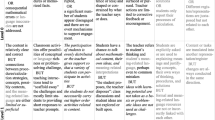Abstract
Educational policy is often based on the assumption that redundancy is a negative factor in dissemination and should be eliminated in order to achieve cost effectiveness. This article examines issues of redundancy in three dissemination contexts: knowledge acquisition and storage; knowledge synthesis; and knowledge utilization. Knowledge utilization and implementation, ultimately the goals of federally supported dissemination efforts, should rely on processes of planned and targeted redundancy of knowledge syntheses to various users.
Similar content being viewed by others
References
Applied Management Sciences. (1981).Human services information clearinghouses: A discussion of policy issues. Silver Spring, MD: Author.
Brandhorst, T. (1990). What are the possibilities for coordinating education information databases?Knowledge in Society: The International Journal of Transfer, 3(2) (this issue).
Emrick, J. A., & Peterson, S. A. (June, 1978).Educational knowledge dissemination and utilization: Synthesis of five recent studies. Washington, DC: U.S. Department of Education, National Institute of Education.
Freides, T. (1983). The federal information controversy from an economic perspective.College and research Libraries, 47, 425–435.
Glaser, E. M., Abelson, H. H., & Garrison, K. N. (1983).Putting knowledge to use: Facilitating the diffusion of knowledge and the implementation of planned change. San Francisco: Jossey-Bass Publishers.
Good, T. L. (1989).Classsroom and school research: Investments in enhancing schools. Policy paper submitted to the U.S. Office of Education, Office of Educational Research and Improvement. Washington, DC. (ERIC Document Reproduction Service No. ED 308191).
kennedy, M. (1989). Studying smoking behavior to learn about dissemination.Knowledge: Creation, Diffusion, Utilization, 11(1), 107–115.
Klein, S. (1989). Research and practice: Implications for knowledge synthesis in education.Knowledge: Creation, Diffusion, Utilization, 11(1), 58–78.
Klein, S. (1990). How can the federal government help education-related clearinghouses?Knowledge in Society: The International Journal of Transfer,3(2) (this issue).
Kranzberg, M. (1981). Communication of scientific and technical information: Implications for federal policy and research.The five-year outlook: Problems opportunities and constraints in science and technology (Vol. II). Washington, DC: National Science Foundation.
Landau, M. L. (1969). Redundancy, rationality and the problem of duplication overlap.Public Administration Review, 29(4), 346–358.
Louis, K. S., Dentler, R. A., & Kell, D. G. (1984).Putting knowledge to work: Issues in educational dissemination (AAI No. 85–6). Abt Associates, Inc. and The Center for Survey Research, University of Massachusetts-Boston. Final synthesis report prepared for the National Institute of Education, Washington, DC.
Louis, K. S., & Rosenblum, S. (1981).Linking R&D with schools: A program and its implications for dissemination and school improvement policy. Washington, DC: U.S. Department of Education, National Institute of Education.
Patton, M. Q. (1988). Extension's future: Beyond technology transfer.Knowledge: Creation, Diffusion, Utilization, 9(4), 476–491.
Subcommittee Staff. (1988, September).Preliminary staff report on educational research, development and dissemination: Reclaiming a vision of the federal role for the 1990's and beyond. Prepared for the Subcommittee on Select Education of the Committee on Education and Labor, U.S. House of Representatives, Washington, DC.
Rich, R. F., & Goldhar, J. (1977). The RDx system: Concepts, strategies, practices—An overview. In M. Radnor, D. Hofler, & R. Rich. (Eds.),Information dissemination and exchange for educational innovations: Conceptual and implementation issues of a regionally-based nationwide system. Part I. Evanston, IL: Northwestern, University Center for the Interdisciplinary Study of Science and Technology.
Rogers, E. M. & Marcus, J. E. (1983). Advances in diffusion theory. In W. J. Paisley & M. Butler, (Eds.),Knowledge utilization systems in education (pp. 251–257). Beverly Hills, CA: Sage Publications.
Rogers, E. M. (1988). The intellectual foundation and history of the agricultural extension model.Knowledge: Creation, Diffusion, Utilization, 9(4), 492–510.
Rothman, J., Teresa, J. G., Terence, K. L., & Morningstar, G. C. (1983).Marketing human service innovations. Beverly Hills, CA: Sage Publications.
U.S. Department of Health, Education and Welfare. (1972).Responsibility and responsiveness: the HEW potential for the seventies (DHEW Publication No. (OS) 72-19). Washington, DC: Department of Health, Education and Weltare.
U.S. General Accounting Office. (May, 1988).R&D funding: The Department of Education in perspective: Report to the chairman, Subcommittee on Select Education, Committee on Education and Labor, House of Representatives (GAO/PEMD-88-18FS) Washington, DC: US Government Printing Office.
Author information
Authors and Affiliations
Additional information
Barbara Lieb is research director, Research Applications Division of the Office of Educational Research and Improvement, U.S. Department of Education, where she formerly managed the the Regional Educational Laboratory Program. Having published and taught extensively in the areas of interpersonal, organizational, and instructional communication, she brings a communication perspective to issues of knowledge utilization. In addition to managing other federally supported dissemination programs for the National Institute of Education, she has served in executive capacities for both the Speech Communication Association and the American Society for Medical Technology, dealing with issues of professional development and knowledge use.
Rights and permissions
About this article
Cite this article
Lieb, B. What is the appropriate level of redundancy in federally sponsored education dissemination programs?. Knowledge in Society 3, 58–68 (1990). https://doi.org/10.1007/BF02687227
Issue Date:
DOI: https://doi.org/10.1007/BF02687227




